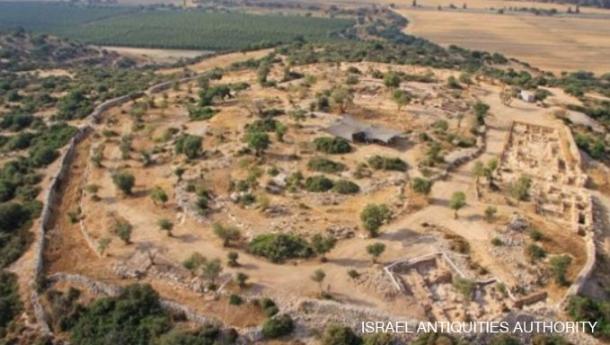Archeological find may be King David's Palace
Archaeologists have uncovered two royal public buildings in the Kingdom of Judah dating back to the tenth century BC which may be the palace of King David and a huge royal storeroom.
The buildings were discovered by researchers of the Hebrew University and the Israel Antiquities Authority in Khirbet Qeiyafa, a city in Judah dating back to the time of King David. Located 30 kilometres southwest of Jerusalem, the site is 2.3 hectares in area and surrounded by massive fortifications of megalithic stones, and is believed to be the biblical city of Sha’arayim, which is mentioned as one of the cities “unto the reign of David”. The city of Khirbet Qeiyafa is also said to be the location of the famous battle between David and Goliath.
Excavations at Khirbet Qeiyafa have taken place over the past seven years and are finally drawing to a close, but the latest finding may be the most significant. According to two archaeologists working on the project, Professor Yossi Garfinkel and Sa'ar Ganor, “Khirbet Qeiyafa is the best example exposed to date of a fortified city from the time of King David”.
The excavation has revealed a large palace extending across an area of approximately 1,000 square metres and enclosed within a wall. Archaeologists have uncovered an impressive entrance to the building, rooms with various installations, including evidence of a metal industry, special pottery vessels and fragments of vessels imported from Egypt. Unfortunately most of the palace was destroyed 1,400 years later, probably during one of the battles fought against the Philistines in 980 BC.
The second building found north of the city is 15 metres long by 6 metres wide and was thought to have acted as an administrative storeroom. According to the researchers, “It was in this building the kingdom stored taxes it received in the form of agricultural produce collected from the residents of the different villages in the Judean Shephelah. Hundreds of large store jars were found at the site whose handles were stamped with an official seal as was customary in the Kingdom of Judah for centuries”.
According to the researchers, the palace and storerooms provide unequivocal evidence of the kingdom’s existence. “To date no palaces have been found that can clearly be ascribed to the early tenth century BCE as we can do now”, they said.
The finding is so significant that plans to construct a new neighbourhood nearby have been abandoned and instead the surrounding area will be declared a national park, enabling the site to be preserved into the future.
See more at:
http://ancient-origins.net/news-history-archaeology/could-3000-year-old-royal-building-be-king-davids-palace-00672#sthash.K8ThUs8g.dpuf
Archaeologists
have uncovered two royal public buildings in the Kingdom of Judah
dating back to the tenth century BC which may be the palace of King David and a huge royal storeroom.
The buildings were discovered by researchers of the Hebrew University and the Israel Antiquities Authority in Khirbet Qeiyafa, a city in Judah dating back to the time of King David. Located 30 kilometres southwest of Jerusalem, the site is 2.3 hectares in area and surrounded by massive fortifications of megalithic stones, and is believed to be the biblical city of Sha’arayim, which is mentioned as one of the cities “unto the reign of David”. The city of Khirbet Qeiyafa is also said to be the location of the famous battle between David and Goliath.
Excavations at Khirbet Qeiyafa have taken place over the past seven years and are finally drawing to a close, but the latest finding may be the most significant. According to two archaeologists working on the project, Professor Yossi Garfinkel and Sa'ar Ganor, “Khirbet Qeiyafa is the best example exposed to date of a fortified city from the time of King David”.
The excavation has revealed a large palace extending across an area of approximately 1,000 square metres and enclosed within a wall. Archaeologists have uncovered an impressive entrance to the building, rooms with various installations, including evidence of a metal industry, special pottery vessels and fragments of vessels imported from Egypt. Unfortunately most of the palace was destroyed 1,400 years later, probably during one of the battles fought against the Philistines in 980 BC.
The second building found north of the city is 15 metres long by 6 metres wide and was thought to have acted as an administrative storeroom. According to the researchers, “It was in this building the kingdom stored taxes it received in the form of agricultural produce collected from the residents of the different villages in the Judean Shephelah. Hundreds of large store jars were found at the site whose handles were stamped with an official seal as was customary in the Kingdom of Judah for centuries”.
According to the researchers, the palace and storerooms provide unequivocal evidence of the kingdom’s existence. “To date no palaces have been found that can clearly be ascribed to the early tenth century BCE as we can do now”, they said.
The finding is so significant that plans to construct a new neighbourhood nearby have been abandoned and instead the surrounding area will be declared a national park, enabling the site to be preserved into the future.
- See more at: http://ancient-origins.net/news-history-archaeology/could-3000-year-old-royal-building-be-king-davids-palace-00672#sthash.K8ThUs8g.dpuf
The buildings were discovered by researchers of the Hebrew University and the Israel Antiquities Authority in Khirbet Qeiyafa, a city in Judah dating back to the time of King David. Located 30 kilometres southwest of Jerusalem, the site is 2.3 hectares in area and surrounded by massive fortifications of megalithic stones, and is believed to be the biblical city of Sha’arayim, which is mentioned as one of the cities “unto the reign of David”. The city of Khirbet Qeiyafa is also said to be the location of the famous battle between David and Goliath.
Excavations at Khirbet Qeiyafa have taken place over the past seven years and are finally drawing to a close, but the latest finding may be the most significant. According to two archaeologists working on the project, Professor Yossi Garfinkel and Sa'ar Ganor, “Khirbet Qeiyafa is the best example exposed to date of a fortified city from the time of King David”.
The excavation has revealed a large palace extending across an area of approximately 1,000 square metres and enclosed within a wall. Archaeologists have uncovered an impressive entrance to the building, rooms with various installations, including evidence of a metal industry, special pottery vessels and fragments of vessels imported from Egypt. Unfortunately most of the palace was destroyed 1,400 years later, probably during one of the battles fought against the Philistines in 980 BC.
The second building found north of the city is 15 metres long by 6 metres wide and was thought to have acted as an administrative storeroom. According to the researchers, “It was in this building the kingdom stored taxes it received in the form of agricultural produce collected from the residents of the different villages in the Judean Shephelah. Hundreds of large store jars were found at the site whose handles were stamped with an official seal as was customary in the Kingdom of Judah for centuries”.
According to the researchers, the palace and storerooms provide unequivocal evidence of the kingdom’s existence. “To date no palaces have been found that can clearly be ascribed to the early tenth century BCE as we can do now”, they said.
The finding is so significant that plans to construct a new neighbourhood nearby have been abandoned and instead the surrounding area will be declared a national park, enabling the site to be preserved into the future.
- See more at: http://ancient-origins.net/news-history-archaeology/could-3000-year-old-royal-building-be-king-davids-palace-00672#sthash.K8ThUs8g.dpuf









